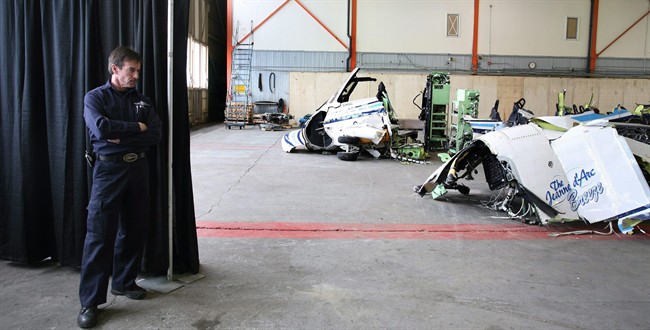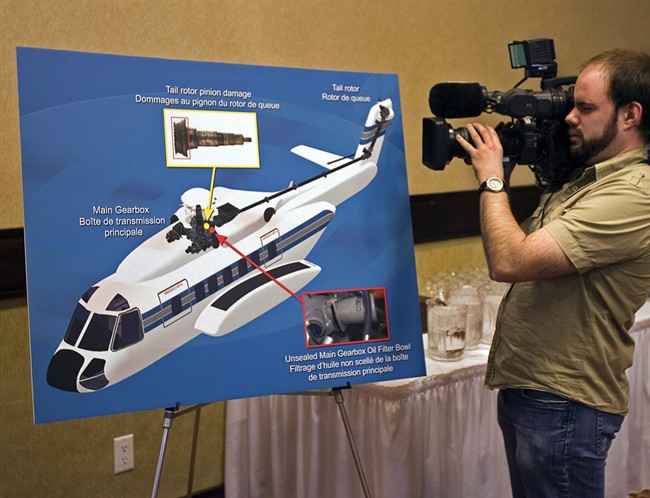Every March, Lori Chynn makes the same journey across Newfoundland, travelling from her Deer Lake home on the island’s west coast to lay a wreath by a stretch of fence in St. John’s.

Ten years ago, it was the last place Chynn’s husband, John Pelley, set foot before boarding a helicopter meant to carry him and his colleagues to a three-week stint on the SeaRose offshore oil platform.
It was a routine trip for all 18 people who left behind their homes and families for the tough three-weeks-on, three-weeks-off work schedule on the rigs.
But for Pelley and nearly all his colleagues who boarded Cougar Flight 491 on the morning of March 12, 2009, the short trip would be their last.
The helicopter experienced a loss of oil pressure and crashed into the North Atlantic, killing 17 of the 18 people on board.
READ MORE: Oversight, training at issue in talks to resume night flights off Newfoundland
The following weeks and months brought harrowing searches, first for the missing helicopter and missing bodies and then for answers as to how and why the awful tragedy occurred.
An inquiry into helicopter safety heard from experts and relatives like Chynn, who found themselves unexpectedly thrust into advocacy work for workers’ rights and safety.
Now 10 years on, the tragedy of Cougar Flight 491 is burned into the collective memory of the small province where everyone has a close connection to the ocean industries that give many their livelihoods, but have claimed lives nonetheless.
An annual service in St. John’s honours the victims of the crash every March 12.

Cougar staff wear memorial pins in the days leading up to the anniversary, which chief operating officer Hank Williams says is a day of reflection for himself and other staff members and a reminder of the dangerous conditions they work in.
Others take the morning to visit a memorial statue by Quidi Vidi Lake in St. John’s, designed to represent the first rotary-type flying machine designed in the 15th century. The steel structure is engraved with 23 names: the 17 killed in 2009 and six other workers who died in a Universal helicopter crash on March 13, 1985.

Get breaking National news
For Chynn, her personal healing has taken many forms.
She’s formed bonds with the other wives and families who lost loved ones, and thrown herself into advocating for helicopter and workplace safety – something Chynn says she felt compelled to do in the spirit of her husband, a medic who always looked for the solution to any problem.
“I felt that I had to continue with that, because he didn’t have a voice, and he would want answers,” Chynn said.
WATCH: Investigation called after Mexican governor killed in helicopter crash

A high-school counsellor, Chynn now plans to transition into bereavement counselling after her heartbreaking loss forced her to confront the different, individualized faces of grief.
As time goes on, she says her annual trip to the former Cougar site gives her an important moment of reflection at the place where her husband left the island.
“I feel compelled to go there,” Chynn said.
“Even though Cougar doesn’t fly out of there anymore, that’s something I’ve done from the first anniversary and I continue to do … it has been part of my healing, it’s part of where I feel I need to be.”
Relatives and friends of those lost in the crash say the impact on families should not be forgotten and the fight for greater safety is as urgent as ever.
St. John’s Mayor Danny Breen lost his brother Peter in the crash, and says the event and the awful months that followed feel both far away and immediate.
READ MORE: Services held to mark year anniversary of deadly N.L. chopper crash

Breen said people still approach him to offer condolences and talk about how much they enjoyed getting to know Peter. Workers spend weeks aboard the rigs and often become like a second family to each other.
“People come up and say, ‘Look, I knew your brother, really sorry, we had a great time together, I really enjoyed him,”‘ Breen said.
“He left a mark on a lot of people and that’s something that I still hear 10 years later.”
Breen said he hopes the issue of safety in the ocean industries doesn’t lose momentum as the years pass.
“Those people were like everybody else – they got up in the morning and went to go to work. It’s just that they went in a different mode, and a much more dangerous form of transportation,” Breen said.
“It’s important to remember that these (things) can happen and we should have the utmost safety for people working in the offshore at all times. We need to be ever vigilant about that.”
READ MORE: Swissair Flight 111 crash 20 years later
The inquiry into helicopter safety, led by retired judge Richard Wells, resulted in a number of recommendations to improve safety in Newfoundland’s offshore industries – where Wells wrote conditions are “probably the harshest in the offshore world.”
The recommendations have yielded significant changes and greater emphasis on helicopter safety, and information sharing between offshore industries.
But some of Wells’ recommendations still have not been met – most glaringly, establishing an independent safety regulator for the province’s offshore industry, as those in Norway, Australia, the United Kingdom and the United States have done.
Lana Payne, Atlantic regional director for Unifor which represents about 700 offshore oil workers on the Hibernia and Terra Nova rigs, said the fight for safety is more important than ever as the province plans expand the industry into deeper, farther and harsher waters.
WATCH: Four Americans dead after helicopter crash in Kenya

Payne says other close calls show how safety in the industry is sometimes considered after profit.
In 2017, the SeaRose was not disconnected as a large iceberg approached and nearly hit the vessel with 84 people and 340,000 barrels of crude oil on board.
An investigation into the incident by the offshore board found the Husky Energy did not follow its ice management plan during the incident.
Another investigation is ongoing into a November 2018 oil spill of 250,000 litres into the ocean – considered the largest in history of the province’s offshore industry – when the Husky restarted production on the SeaRose platform during a fierce storm.
Payne says while the culture of talking about safety in the offshore industries has changed, there is still “chill” that prevents workers from bring their concerns forward, showing a culture shift is still needed.
As production moves farther afield, Payne stressed that safety should be considered before, rather than after another tragedy occurs.
“Working people can no longer be giving their lives in order to make workplaces safer,” she said.



Comments